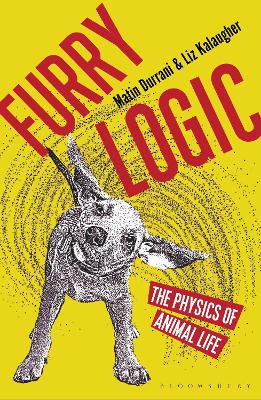
The animal world is full of mysteries. Why do dogs slurp from their drinking bowls while cats lap up water with a delicate flick of the tongue? How does a tiny turtle hatchling from Florida circle the entire northern Atlantic before returning to the very beach where it hatched? And how can a Komodo dragon kill a water buffalo with a bite only as strong as a domestic cat's?
These puzzles - and many more besides - are all explained by physics. From heat and light to electricity and magnetism, Furry Logic unveils the ways that more than 30 animals exploit physics to eat, drink, mate and dodge death in their daily battle for survival.
Along the way, science journalists Matin Durrani and Liz Kalaugher introduce the great physicists whose discoveries helped us understand the animal world, as well as the animal experts of today who are scouring the planet to find and study the animals that seem to push the laws of physics to the limit.
Presenting mind-bending physics principles in a simple and engaging way, Furry Logic will appeal both to animal lovers and to those curious to see how physics crops up in the natural world. It's more of a 'howdunit' than a whodunit, though you're unlikely to guess some of the answers.
Well, I finished it, and I got lousy about doing status updates, but it's all Chapter 3s fault: the bit about cats drinking water had me wanting to post an Easter-cat video of her drinking from the tap/faucet in slow motion. But apparently BookLikes doesn't like embedding any video that isn't YouTube and I don't want to create a freaking YouTube account just so I can post a video of Easter-cat showing the physicists how it's done. So I had a minor hissy fit and sulked for the remaining three chapters.
Be thankful I didn't take my suspicions about the time it takes mammals to urinate any further, is all I'm saying.
I found the section about elephants in chapter 4 both interesting and tense - thumbs down to the authors for trying to inject suspense in the narrative at the expense of a baby elephant. TOTAL SPOILER ALERT: he's fine - happy ending. Take that Durrani and Kalaugher. The parts about the bats and the snakes I sort of knew already, although the level of detail built on the basic, working knowledge I had on both.
Chapter 5 found me mostly feeling sorry for the eels. The whole tone of that section felt very old-school, let's torture them for Science! - I don't think that's the attitude of the authors themselves, but by the end of it, yeah, I mostly just felt really bad for the eels. Though I love the bit about Miguel Wattson at the Tennessee Aquarium (which is brilliantly done, by the way - genius - and I highly recommend taking the time to visit if you're ever in Chattanooga). The section about the bees detecting electrical fields around flowers was something I'd read elsewhere recently, but I loved the information about the Loggerheads. The authors focused on the East Coast of Florida, but my West Coast home (far superior side of the state, in my opinion) beaches are also popular and busy nesting spots for these majestic creatures and it's the normal way of things to see roped off squares of beach during the nesting season. Seeing the females come up the beach is an awesome experience.
Chapter 6 had me at the start, but then started losing me in all the descriptions of mathematical equations and formulas. It rallied briefly with the triggerfish, because they're both awesome and native to Australia, which means, unlike the red garter snakes in Canada, I have an outside chance of seeing a small fish shoot bugs out of the air in the wild. Just imagine if I stumbled across a whole school of them on a particularly buggy morning; it'd be like mother nature's own Bellagio!
The final question about whether animals really know they're using physics was answered, I think, perfectly. Most humans don't know they're using physics every day; Beckham just bends it and doesn't think about how. But I do take exception to the backwards way they approach animal intelligence. We don't know how intelligent animals are, but our default answer is the obvious confirmation biased one. Given the state of the planet, I'm not at all sure the bees and ants don't have it all going on over us. They've both managed to colonise the planet without burning it down, after all.
Mostly, I enjoyed the book; I liked the angle they authors took to bring physics to the everyday world, and make the reader consider just how much we're all beholden to the laws of the universe. The humor mostly fell flat for me, but I appreciated the effort.
Reading updates
-
Started reading
-
27 March, 2019:
Finished reading
-
27 March, 2019:
Reviewed
